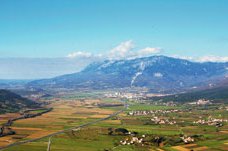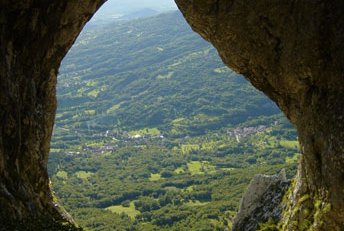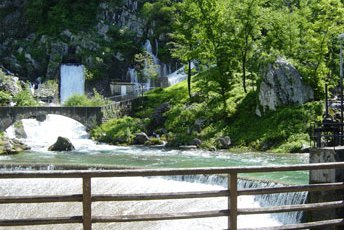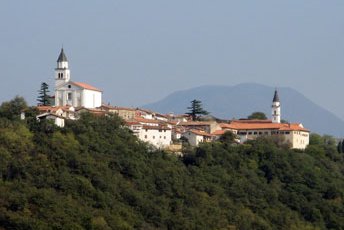Vipava Valley
Upper Vipava Valley is at the western part of Slovenia and represents a passage from Furlan lowland to central Slovenia. From east towards the west it is surrounded by highlands Nanos, Hrušica and Trnovo Woodlands. In the south it is separated from Kras by Vipava hills. Its characteristics are its geographical fluctuations because absolute heights above sea level vary between 60 meters (part of Vipava river under Batuje village) and 1495 meters (Mali Golak).
The territory is covered by Ajdovščina and Vipava municipalities. The total area is 352 km2 and has about 22.500 inhabitants.
Important particularity of the valley that influences all life in the area is its oppenes towards west. From this side Mediterranean climat reaches it and this is the reason why the vegetation time is two months shorter than in central Slovenia. Because of this tipically Mediterranean plants grow here (figs, laurel…). Despite this the climate uppon northern highlands is continental which means snow in winter. Mixing of both climates helps to a bigger biodiversity of animal and plant species. There are many endemites amongst them.
When we talk about climate we must not forget the famous Kras bora. This north-east wind blows strongly from mountain heights into the valley with speeds up to 180 km/h. It shapes importantly the lives of the inhabitants.
Historians have discovered that Vipava valley was already inhabited before 0 A.D., maybe even in later stone age. The big boom has surely came at the times of the roman Empire. There are several excavation sites to prove that. In this area a famous battle took place between two houndred thousand man armies of Teodozij The Cesar and his opponent Evgenij. This battle shaped the whole of Europe latter on. The armies fought for two days (on 5th and 6th of september 394) and the final result is considered to be the splitting of the roman Empire in two parts.
Many rich and important man wre comming to Vipava valley. It is full of castles and has a nick name The Valley of Courts and Castles. We find them in Vipava, at Col, Slap, Velika Žablje, Vipavski Križ and elsewere. Many of them though are in poor state but some, like court Zemono, still demonstrate their glory.
Rich cultural heritage is a caracteristic of Vipava Valley. First and foremost we must not forget many churches dating from the gothic times on. Whole settlements are considered cultural monuments like Vipavski Križ, Šmarje and urban centers of Vipava and Ajdovščina. At Tabor village above Črniče one of rare camp settlements remained in good condition.
A traveler quickly notices farming. At lowlands the climat is ideal for fruits and vegetables. At hills insolated by sun we have wineyards used to produce fine wine. People from this region have in Valvasor times supplied Vienna and other big cities with fruits (cherries, peaches and apricots). At almost every village of this wine region, arched cellars have remained functional (»velbani hrami«). People use to sing and greet foreigners in them. Industrialisation began its rapid progression after the second world war. Fortunatelly there is no heavy industry in the valley. There are many food processing plants but also textile, wood and building industry. Most prominent companies are Agroind, »Vipava 1894«, Fructal, Tekstilna, Primorje, Lipa and other smaller ones.




